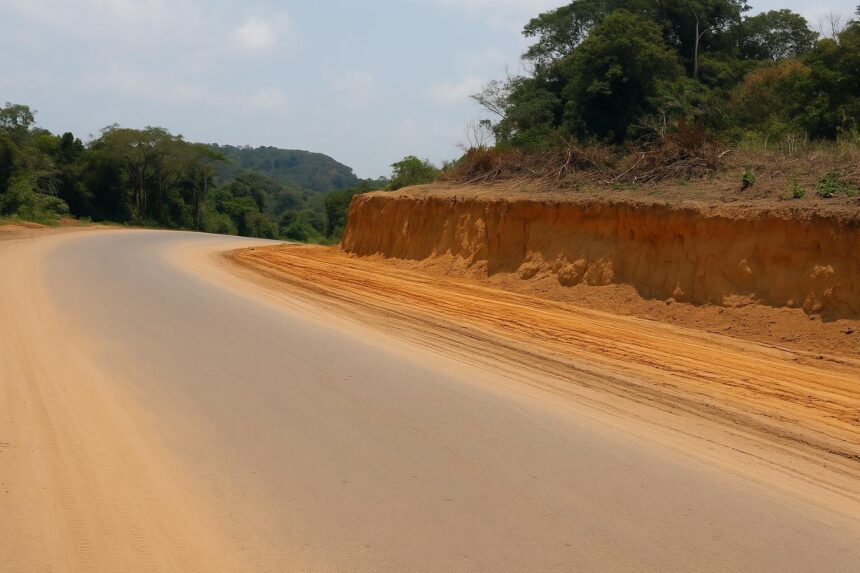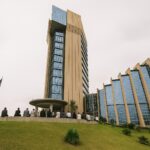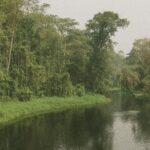Mbamba curve finally widens
The legendary right-hand hairpin nicknamed Mbamba, just past Inoni Falaise on National Road 2, has long reminded motorists that the trip from Brazzaville to the North begins with a test of nerve. Its steep camber and tight radius leave no space for hesitation.
Drivers approach the bend, brake hard, dive downhill, wrestle the steering left at the last instant, then climb back up while engines and pulses thump. The slightest distraction may send a vehicle toward drops half-hidden by forest on both sides of the narrow pavement.
That anxiety should soon ease. A government-backed project is enlarging the carriageway, easing the camber and improving drainage exactly at Mbamba. Civil engineers on site say the new geometry will give sedans, buses and timber trucks a safer line with enough shoulder to correct errors.
Brazzaville-Ollombo overhaul in full swing
The makeover forms part of the 388-kilometre rehabilitation between Brazzaville and Ollombo, a backbone link for trade, farm supplies and passenger travel to Cuvette and Likouala. Crews have been milling failed asphalt, laying fresh bitumen and repainting lines where rain and heavy axles had carved ruts.
On good days one lane stays open, letting convoys snake through at thirty kilometres per hour under flaggers’ whistles. On bad days impatience builds, yet most road users prefer delays now to potholes. “We lose less fuel idling than bouncing,” taxi driver Claude Diafouka smiles.
Public Works officials along the detour keep the same timetable: major surfacing should finish before the next rainy season, with painting and signage to follow. They stress that heavy culverts already in place will limit washouts that once made some sections impassable overnight.
A safer, smarter Mbamba
At Mbamba itself, workers first cut back roadside vegetation to open sightlines. They then blasted rock to widen the platform by nearly four metres, laid a geotextile to stabilise the slope and poured a new sub-base. Asphalting teams are expected within days once compaction tests return satisfactory results.
Engineers claim the redesigned curve will tolerate articulated trucks at forty kilometres an hour, double the previous safe speed. Guardrails are planned on the outer edge, while reflective chevrons will guide night traffic. For daily commuters from Ngo, that difference means shorter travel times and calmer steering wheels.
Road-safety instructor Marie-Thérèse Kouvavou welcomes the change but reminds drivers that geometry is only half the battle. “You still need functioning brakes, rested eyes and respect for weight limits,” she insists, pointing at skid marks fading under the fresh mat. Her team distributes leaflets at nearby markets.
How to pay for smoother rides
Once the Brazzaville-Ollombo corridor shines end to end, attention turns to upkeep. The route hosts fewer toll and weigh stations than the Brazzaville–Pointe-Noire highway. Analysts say economic realities may soon require extra checkpoints to fund maintenance, lighting and emergency response.
The principle is not new. Across the continent, user-pay models help roads avoid the fate of costly repairs every few years. Still, transport unions stress the need for transparent tariffs and functioning services in return. Clean rest areas, reliable weighing scales and quick incident clearance top their wish list.
Officials respond that any additional toll gates would come with electronic payment, solar lighting and staffed first-aid kiosks. “We learn lessons from every corridor,” notes director of roads Jean-Patrick Okemba, citing the five tolls over the 536 kilometres to Pointe-Noire. “Drivers deserve value for each franc contributed.”
Pilot weigh-in-motion sensors tested near Gamboma register axle loads without halting traffic, trimming queues and targeting the worst offenders. Engineers say the same lasers could guard Mbamba once the widened curve reopens.
Northbound pulse of commerce
For traders carrying cassava, charcoal or bush mangoes from Owando toward Brazzaville’s markets, a smoother RN2 slashes journey time and spoilage. For bus operators, fewer breakdowns mean respectable timetables and loyal passengers. Economic planners expect an uptick in cross-regional traffic once Mbamba ceases to be a bottleneck.
The project also holds social value. Villagers near the curve have been hired as flaggers, cooks and watchmen, bringing temporary wages and skill training. Local leaders voice hope that better access will draw teachers, nurses and tourists to their hillside communities tucked between teak stands and red-clay gullies.
While the final asphalt cools, authorities urge vigilance. Speed limits will remain at sixty kilometres an hour through the works zone until every sign and guardrail is bolted down. For frequent travellers, patience now promises years of calmer rides, lower repair bills and perhaps new roadside coffee stalls.
Mbamba’s sharp bend once symbolised the hardship of reaching the country’s northern heartlands. Soon its broad, well-marked lanes could become a showcase of modern Congolese engineering, reminding every driver that good roads do more than move traffic; they connect families, freight and futures at the speed of opportunity.




















